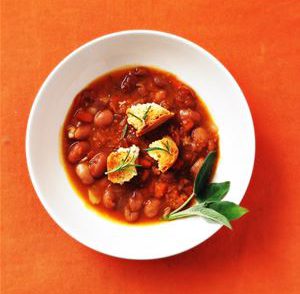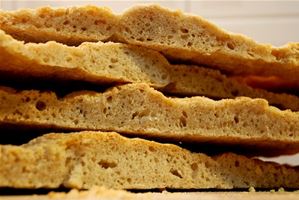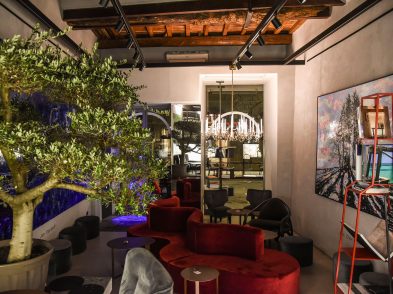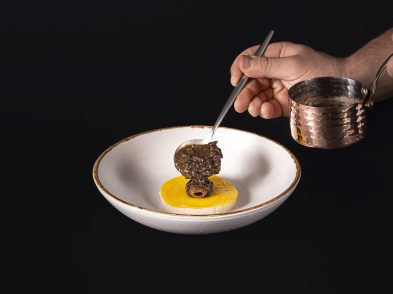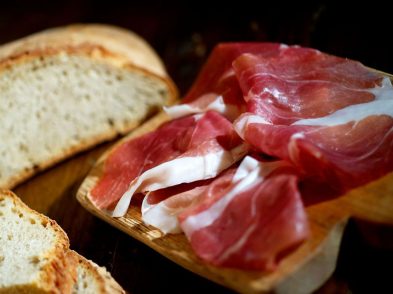When I moved from New Zealand to Italy in 2001, I missed many things from home. Not only was the spoken language different, but the difference was deeper than vocabulary: the sentence structure of Italian was so unlike that of English; Italian has both formal and informal address, expressed in the pronouns, which English does not have. Keys turn the opposite way in the locks. Italians drive on the wrong side of the road and get into the wrong side of the car. Then, there were the serious differences: the foods. I could not get avocados, marmite, limes, coriander, fresh mint. Worse, there was no bacon.
Go to your local Tuscan salumeria and you will find everything from the pig but the oink. Salame, salumi: prosciutto dolce, prosciutto salato, cappocollo, salsiccia fresca, salsiccia secca. Or, as the saying goes, del maiale non si butta via nulla!
Expect to see seasoned dried pigs’ trotters hanging from the rafters, ready to soak for two days and add to soup for flavour. The horseshoe-shaped rings of delicious blood sausage made from fresh pigs’ blood, apple and pigs’ fat emulsified together, poached in vats of gently boiling water, then hung, to set, on long wooden poles high above the butcher’s floor. In the salumeria, pigs’ livers become part of a pork terrine; pigs’ tongues are boiled with bay leaves, peppercorns and red onions and then they are peeled, squashed and set in a natural jelly; pigs’ heads are slowly boiled for hours to make headcheese or braun, infused with fresh herbs and lemon zest. Pigs’ intestines are used as natural sausage casings. Hanging above you are rows of beautiful cured pigs’ legs, often with the hoof still attached, that have been cured and aged for many months to become prosciutto dolce, prosciutto salato. Lardo is pure fat taken and from the pig’s back and cured; capocollo is cured from the shoulder; guanciale is cured cheek. The list goes on.
And then there is pancetta. Whereas bacon spits fat in the pan if it has been wet-brined, needs to be cooked, and is better eaten hot, pancetta is its yummy mean cousin. You can eat it cured and cold without having to fry it, the fat melting in your mouth like lard. Or dice it up and sauté it for a pasta sauce, spread it sliced thinly over the breast of an oven-roasted bird, put it in stuffings: the possibilities are endless.
Pancetta is a pork belly cured with salt, pepper and seasonings, sometimes rolled and tied, sometimes smoked. Bacon is exactly the same thing, but different. Commercial varieties of bacon are often wet-brined and pumped full of salt and water to keep the yield up. Italian pancetta is generally dry cured and, because more fat is usually on the belly, it has more flavour at the finish.
I make all types of pancetta: dry cured, wet cured and marinated, cold smoked, hot smoked. Here I offer my most basic recipe for dry-cured pancetta, which can be used in a wider variety of recipes. It also lasts in the fridge a very long time—if you have the power to stay away from it!
Believe me when I say it takes longer to read this recipe than to make the pancetta. It is ready to use in a few short weeks and requires very little attention while you are waiting for it to cure. In my next article, I will share some special recipes using your homemade pancetta. So cure your pork belly now and in four weeks your pancetta will be ready in time for the recipes.
Buon appetito!

Pancetta: How to make it
INGREDIENTS
1kg–1.5kg fresh piece of pancetta di maiale, not too lean, not too grasso.
45g rock salt
One glass of white wine, such as Spinetta Vermentino Toscana IGT
One clove garlic
15g good-quality whole black peppercorns
5g dried chili flakes
5g fennel seeds
PREPARATION
Remove the rib bones from the pancetta with the tip of a boning knife. Remove the excess fat from the top, trim neatly all around and leave the skin on.
Rub the whole piece of pancetta (pork belly) in the rock salt and store skin side up in a noncorrosive container. Cover with a weight and refrigerate for three days. Each day, remove the accumulating liquid that the salt is drawing out of the pancetta.
After three days, check to see if the meat has become a richer red in colour and the whole belly has become firmer from absorbing the right amount of salt. In addition, a slightly transparent hue should have developed. If so, remove the belly from the fridge and wash with the glass of Vermentino. Pat dry to ensure all traces of excess salt have been removed. Cut a clove of garlic in half and rub the whole belly including the skin, with the garlic, then discard.
Dry roast some good-quality black peppercorns in a heavy-based pan, cool, and then grind in a spice grinder to medium grains. Sprinkle abundantly over the pancetta, covering thoroughly (do not let any part of the flesh remain uncovered with seasoning). Massage in the pepper for a couple minutes, and then sprinkle the chilli flakes and fennel seeds over the belly for extra flavour.
To hang the pancetta, pierce a small hole through the top of the largest muscle in the middle, which is the heavy end, and tie a piece of string through with a loop. This pancetta is now ready to hang in your cantina, a cool, dark, well-ventilated food pantry or storage space or, lacking any of these, your refrigerator. Within a month, without any further effort on your part, the pig’s belly will become pancetta.
A good test to determine whether your pancetta is ready is its smell. If it smells like a cured salame from your local salumeria, get a very sharp knife, slice off a couple of wafer-thin slivers and taste. You’ll know if it has turned to pancetta!

